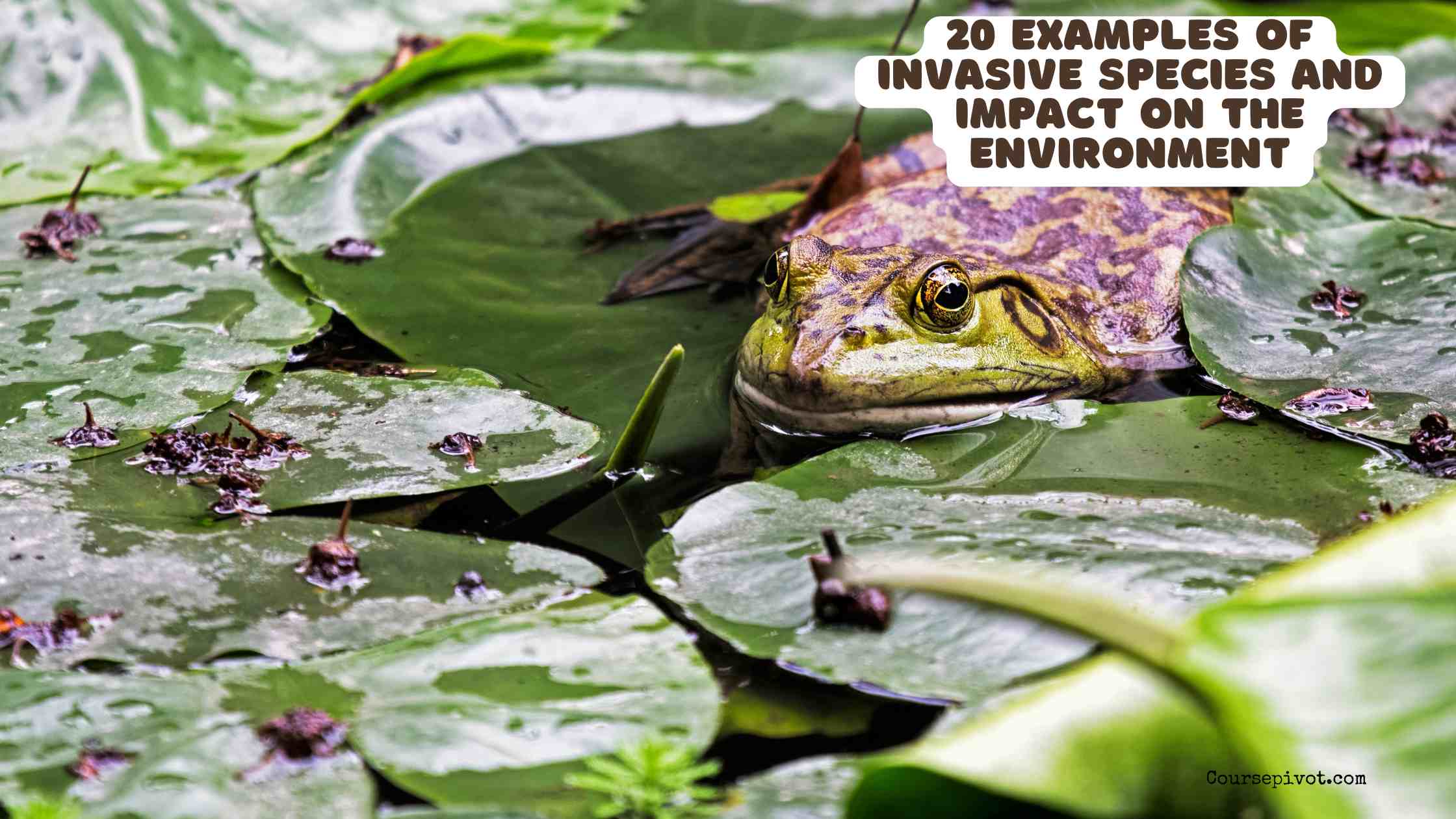
20 Examples of Invasive Species and Impact on the Environment
Invasive species are non-native organisms that spread aggressively in new ecosystems, often causing ecological disruption by outcompeting native species, altering habitats, and reducing biodiversity. They can lead to extinctions, economic losses, and ecosystem imbalances, with global impacts estimated at billions annually. Below, I’ve compiled 20 well-documented examples from various regions, drawing from established cases like those involving plants, animals, insects, and aquatic species. Each includes the species, its origin, where it’s invasive, and key dangerous environmental effects. These examples highlight the severe consequences, such as habitat destruction and loss of native biodiversity, emphasizing the need for prevention and control.
- Kudzu (Pueraria montana) Origin: Asia. Invasive in: Southeastern United States. Effects: This fast-growing vine smothers native plants and trees, blocking sunlight and leading to forest canopy collapse; it reduces biodiversity by displacing understory vegetation and alters soil nutrients, contributing to erosion in affected areas.
- Zebra Mussels (Dreissena polymorpha) Origin: Eurasia. Invasive in: Great Lakes region, North America. Effects: They filter out plankton, starving native aquatic species and disrupting food chains; massive colonies clog waterways, reduce water clarity, and promote algal blooms, harming fish populations and ecosystem balance.
- Burmese Python (Python bivittatus) Origin: Southeast Asia. Invasive in: Florida Everglades, USA. Effects: As apex predators, they devour native mammals like deer and birds, causing up to 90% declines in small mammal populations; this disrupts food webs and threatens biodiversity in wetlands.
- Emerald Ash Borer (Agrilus planipennis) Origin: Asia. Invasive in: North America (e.g., USA, Canada). Effects: Larvae kill ash trees by boring into bark, leading to widespread forest die-off; this creates gaps in canopies, allowing invasive plants to thrive and reducing habitat for birds and insects.
- Cane Toad (Rhinella marina) Origin: South America. Invasive in: Australia. Effects: Their toxic skin secretions poison native predators like snakes and quolls, causing population crashes; they outcompete local amphibians for resources, altering wetland ecosystems and reducing biodiversity.
- European Starling (Sturnus vulgaris) Origin: Europe. Invasive in: North America. Effects: Aggressive nesting displaces native birds like bluebirds, reducing cavity-nesting species by 20–30%; they consume crops and spread diseases, impacting agricultural ecosystems and avian diversity.
- Lionfish (Pterois volitans) Origin: Indo-Pacific. Invasive in: Atlantic Ocean, Gulf of Mexico (e.g., Caribbean, USA coasts). Effects: As voracious predators, they eat native reef fish, reducing juvenile populations by up to 80% and disrupting coral reef food chains, leading to ecosystem collapse.
- Feral Pigs (Sus scrofa) Origin: Eurasia. Invasive in: United States, Australia. Effects: They root up soil, destroying vegetation and promoting erosion; they prey on native fauna like ground-nesting birds and amphibians, causing habitat degradation and species declines.
- Cheatgrass (Bromus tectorum) Origin: Eurasia. Invasive in: Western United States. Effects: This grass outcompetes native plants, altering fire regimes by burning more frequently and intensely; it reduces sagebrush habitats, threatening species like the sage grouse and increasing desertification.
- Asian Carp (e.g., Silver Carp, Hypophthalmichthys molitrix) Origin: Asia. Invasive in: Mississippi River Basin, Great Lakes (USA). Effects: They consume vast amounts of plankton, starving native fish and disrupting aquatic food webs; jumping behavior injures boaters and wildlife, while their spread threatens biodiversity in rivers.
- Brown Tree Snake (Boiga irregularis) Origin: Southeast Asia/Pacific. Invasive in: Guam (USA territory). Effects: They prey on native birds, reptiles, and small mammals, causing the extinction of 10–12 bird species; this has led to ecological imbalances, with forests losing seed dispersers and insect populations surging.
- Mediterranean Fan Palm (Washingtonia robusta) Origin: Mexico. Invasive in: Southern California, USA. Effects: It shades out native riparian plants, altering water flow and increasing fire risk; seeds spread via birds, reducing habitat for endangered species like the least Bell’s vireo.
- Giant Hogweed (Heracleum mantegazzianum) Origin: Caucasus region. Invasive in: United States, Europe. Effects: Its sap causes severe skin burns upon sunlight exposure, harming humans and animals; it outcompetes native plants along rivers, leading to erosion and loss of wetland biodiversity.
- Red Imported Fire Ant (Solenopsis invicta) Origin: South America. Invasive in: Southeastern United States. Effects: They sting native insects, reptiles, and ground-nesting birds, reducing populations by 50% in some areas; soil mounds disrupt agriculture and habitats, promoting erosion.
- Common Buckthorn (Rhamnus cathartica) Origin: Europe/Asia. Invasive in: Midwest and Northeast USA. Effects: It shades out native understory plants, reducing forest diversity; berries are toxic to some wildlife, and it alters soil chemistry, inhibiting native tree regeneration.
- Asian Longhorned Beetle (Anoplophora glabripennis) Origin: Asia. Invasive in: United States (e.g., Massachusetts, New York). Effects: Larvae bore into hardwood trees like maples, killing them and creating urban forest gaps; this reduces carbon sequestration and habitat for birds and insects.
- Eurasian Watermilfoil (Myriophyllum spicatum) Origin: Eurasia. Invasive in: Lakes and rivers across North America. Effects: Dense mats block sunlight, killing submerged plants and reducing oxygen levels, leading to fish die-offs; it alters aquatic ecosystems, harming native species like turtles.
- Nutria (Myocastor coypus) Origin: South America. Invasive in: Louisiana wetlands, USA. Effects: They burrow into levees, causing erosion and flooding; voracious eating of vegetation destroys marshes, accelerating habitat loss for birds and contributing to coastal subsidence.
- Japanese Knotweed (Fallopia japonica) Origin: Asia. Invasive in: United States, Europe. Effects: Aggressive rhizomes damage infrastructure and outcompete native plants, reducing riparian biodiversity; it alters soil stability, leading to erosion along riverbanks.
- Northern Giant Hornet (Vespa mandarinia) Origin: Asia. Invasive in: Pacific Northwest, USA (e.g., Washington). Effects: They raid beehives, killing up to 50% of honeybee colonies and threatening pollination; stings pose risks to wildlife and humans, disrupting forest ecosystems.
Practical Tips for Addressing Invasive Species
To mitigate these dangers:
- Prevent Spread: Clean boots and vehicles before entering new areas to avoid transporting seeds or eggs.
- Report Sightings: Use apps like iNaturalist or contact local wildlife agencies for early detection.
- Support Control Efforts: Participate in removal programs or advocate for policies like the U.S. Invasive Species Executive Order.
- Plant Natives: In gardens, choose local species to reduce invasion risks.
- Educate Others: Share information on platforms like social media to raise awareness.
These actions can curb impacts; for instance, community removals have reduced kudzu coverage by 30% in some U.S. areas.
Why Invasive Species Matter
Invasive species threaten global biodiversity, with 42% of endangered species affected by them. Their effects cascade through ecosystems, costing billions in control and lost resources. Early intervention is key to protecting native habitats.
Read 7 Reasons Why Invasive Species Are Dangerous to the Environment
Key Takeaways
Invasive species like kudzu (smothers forests), zebra mussels (disrupts aquatic life), and Burmese pythons (decimates mammals) wreak havoc by outcompeting natives, altering habitats, and reducing biodiversity. From fire ants stinging wildlife to lionfish preying on reef fish, these 20 examples illustrate widespread environmental damage. Dr. Elena Voss, an ecologist, stresses that preventing introductions through awareness and policy is essential to safeguarding ecosystems.
Cite this article
You can copy and paste your preferred citation format below.
Martin, L. & Arquette, E.. (2025, September 16). 20 Examples of Invasive Species and Impact on the Environment. Coursepivot.com. https://coursepivot.com/blog/20-examples-of-invasive-species-and-impact-on-the-environment/



